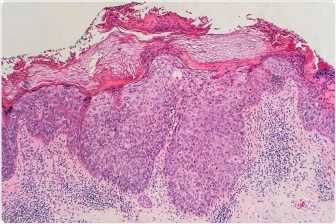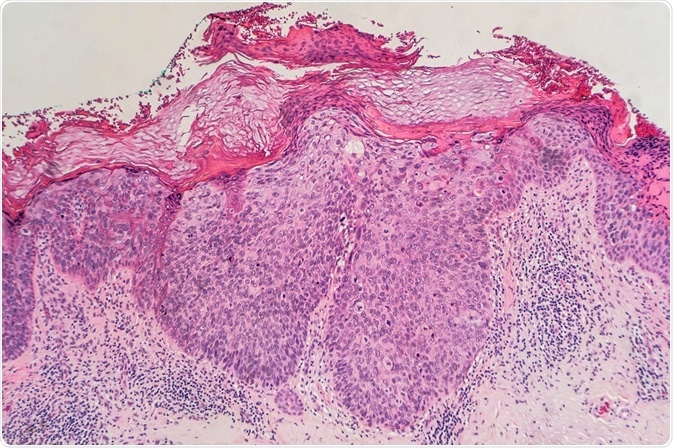Bowen's Disease Signs and Symptoms

Bowen’s disease (BD) is neither a genetically transferable disease, nor one caused by direct contact through skin, but can occur anywhere in the body and is usually seen on the lower legs. Red scaly patches, warts, or spots on the epidermis are the general symptoms of this disease.

Often, the skin becomes sore, itchy, and sometimes bleeds and forms scab due to scratches. This disease is precancerous, in which lesions grow visibly on the upper layer of the skin. It does not cause any serious damage to the vascular bundle and endodermis.
The risk of getting Bowen’s disease is greater only when patients have already had exposure to radiotherapy treatment in the affected area. Very less possibilities are there when exposed to arsenic elements, as the lesions are seen over the skin with single or multiple patches.
The patches seem red-brown in color with a mild inflammation. They resemble sclerosis and a thin form of psoriasis, dermatophyte infection, or dermatitis.
General Signs
- Thin, scaly, and reddish-brown patches appear and persist for a number of years.
- Presence of single or multiple numbers of uneven patches.
- The edges of the patches are irregularly shaped, and can be seen distinctly from the other layers of skin. It grows very slowly with no specific signs.
- Usually SCC in situ has no symptoms, it seems asymptotic in nature, and therefore it can be overlooked easily.
- In Bowen’s disease, possibilities are greater in the lower part of the legs.
- Patches usually appear on the highly sun exposed areas of skin. However, it can also be found in other areas, possibly in the genital region. The patches seen in these areas are more prone to cancer.
- Rarely, the patches become sore and itchy.
- Red patches may sometimes crack or ulcerate and often bleed. If that persists further, it may be a sign of the patches becoming cancerous.
- During its primal stage, people confuse it with psoriasis or ringworm, as there are no symptoms on patches like itch, pain, etc.
Due to intradermal carcinoma, persistent and non-elevated patched red scaly plaques occur, with a possibly cancerous outcome. These proliferate to atypical squamous cells, which resemble fish scales.
The patched lesions can appear anywhere on mucosal surfaces or on the surface of the skin. In general, arsenic compounds are found to be the component of mild BD occurrence. As a result, the lesions found are single patched in half the BD affected cases.
Signs of BD based on location affected
The effect of SCC in situ varies with the locations. Usually it occurs on skin when exposed directly to sun rays, affecting the scalp, top layer of lips, and back of ears. Possibilities are there to occur anywhere on the body, including inside buccal cavity and in the genital areas. BD presents in the skin as a slow growing, well-demarcated plaque with uneven borders and scaled skin layers or crusted layer.
- After the lower limb, the head and neck are the frequently affected regions. The lesion sizes in these regions range from a couple of millimeters to centimeters. The size and shape of the lesions are regularly formed with sharp boundaries. Severe types of BD usually accumulate in the nails and genitals with crusted trauma and are ulcerated. In these affected regions, the lesions accumulate as malignant melanoma.
- The pigmented lesions are seen particularly in the unexposed genital regions. Erythroplasia of Queryatis a lesion usually occurring on the glans of penis. In addition, reduced pigments were noted in the nails and it appears as malignant melanoma. The highest percentage of BD affects Caucasians, who are associated with Fitzpatrick type skin. In Caucasians, effects are noted in 1.42 of every 1000 persons. Risk factors are mostly associated with increase of eryhroplasia of Queryat, which are not circumcised with chronic inflammation.
Gender Specificity
It affects any age group and is not a gender-specific disease, but very rarely affects those who are below the age of 30. Additionally,, patients are mostly above 60-years old, and it rarely affects the soles or palms. BD affected people are mostly women (around 75–80% cases are women) and about three-fourths are affected with lesions on the lower leg (60–85% cases are due to direct exposure to sunlight).
However, men who are highly exposed to UV rays at work also show BD symptoms. Women are more prone to BD in genital areas, i.e., three times as likely than men. It also frequently affects those who take immunity suppressing drugs.
Though with proper medications and treatment, SCC in situ can be cured, evaluating at every quarter after treatment is needed. Strategies like freezing, cauterization, and diathermy coagulation are highly effective treatments for Bowen's disease being prescribed nowadays. In addition, before any problems persist further, regular checkups and continuous monitoring of patches results in proper healing of the skin.
Sources:
- https://rarediseases.org/rare-diseases/bowen-disease/#symptoms
- www.betterhealth.vic.gov.au/…/bowens-disease#lp-h-0
- www.google.co.in/url
- www.mayoclinic.org/…/syc-20352480
- https://www.medigest.uk/diseases/bowens-disease/
- http://www.advanced-dermatology.com.au/bowens-disease
Further Reading
- All Bowen's Disease Content
- Bowen’s Disease / Squamous Cell Carcinoma in Situ
- Bowen’s Disease Causes
Last Updated: Feb 26, 2019
Source: Read Full Article